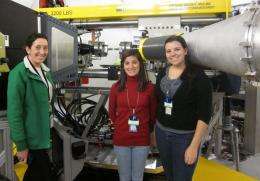Spallation Neutron Source user finds 'perfect instrument' for materials research

Stress, fatigue and heavy loads aren't always negative elements of work - in fact, they are what attracted Jennifer Forrester to the Spallation Neutron Source at Oak Ridge National Laboratory.
Forrester, a research scientist working in the research group of professor Jacob Jones at the University of Florida, came seeking stress at SNS as part of her work on piezoelectric ceramics. Applying stress to piezoelectric crystals produces an electric field, whereas applying an electric field to the same material causes a shape change.
These unique properties make piezoelectrics valuable for diverse applications in such consumer products as cell-phone touch screens, fuel injection, airbag deployment sensors, fire igniters and guitar pickups.
"What we're trying to do is improve them -- put a higher electric field on them and have more shape change. Or the other way around -- put a higher load on them so that they put out a corresponding electric field. The more shape change you can get out of them, the more potential applications you have," Forrester said.
Traditional piezoelectric materials contain lead, an element that materials researchers are now trying to avoid because of environmental concerns. One lead-free alternative, sodium bismuth titanate, or NBT, was the focus of Forrester's latest neutron diffraction study at SNS.
Forrester and her students were the first users of a new load frame at VULCAN, a diffractometer among the suite of instruments that receive intensely pulsed neutron beams at the SNS facility.
"For applying high mechanical loads, VULCAN is the perfect instrument," Forrester said.
Aided by VULCAN's new equipment, Forrester and her team applied static loads to different compositions of the NBT samples to gauge their strength. Initial observations revealed certain compositions that had fracture stresses about double some of the lead-based materials.
"We're trying to work out exactly why two compositions of our NBT were about five times the strength of other compositions. We want to know why they're so much better," Forrester said.
Neutron analysis gives Forrester an extra edge analyzing subtle differences and improvements in the samples' performance.
"NBT is an oxide, and neutrons have a huge advantage when it comes to studying oxides because of the different scattering factors between x-rays and neutrons," Forrester said. "Oxygen has a low scattering factor when using x-rays, and pin-pointing the oxygen locations is important in structural analyses of these materials."
Sample size also plays a role in choosing neutrons over x-rays, says Forrester.
"Our samples are large, and x-rays can only penetrate so far into the sample. It would be difficult to obtain bulk results with x-rays, because they can't penetrate far below the surface. A solid surface can behave differently than the bulk material," Forrester said.
Forrester is already planning her next experiment at SNS, where she hopes to use a new instrument, NOMAD, to study how her samples respond to electric fields.
"After conducting an experiment at VULCAN, you do realize what a nice setup they have for running these types of experiments," Forrester said. "They have a very knowledgeable group of instrument scientists. After you tell them what you want to do, they make it happen."
Provided by Oak Ridge National Laboratory



















